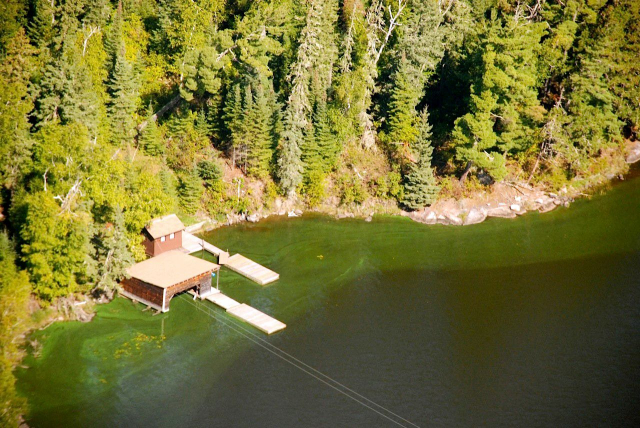 Nutrients and algae are one of the issues facing our watershedLast week, I outlined what a “watershed” is and described the geography of ours – the Rainy-Lake of the Woods Watershed. It is huge and diverse, so it goes without saying that the environmental issues are just as diverse.
Nutrients and algae are one of the issues facing our watershedLast week, I outlined what a “watershed” is and described the geography of ours – the Rainy-Lake of the Woods Watershed. It is huge and diverse, so it goes without saying that the environmental issues are just as diverse.
Low populations, fairly low industrial impacts, lots of forest cover and water all make for a generally healthy watershed. But over the years as more attention turned towards ecosystem health, it became clear that there are, indeed, environmental stresses here and what is a stress on Lake of the Woods is not necessarily a stress upstream. Let’s go on a tour of the watershed from east to west and see how the issues differ as we move downstream
In the headwaters on the Canadian side, most of the land is protected from development within Quetico Provincial Park; water quality is fairly good but influenced by underlying bedrock geology. On the U.S. side, forest and wetlands dominate, but mining in the Iron Range of Minnesota has raised concerns about potential contamination of land and waters. Draining of wetlands is also likely a stressor on biological communities.
As we move downstream towards the central watershed, increased runoff and impacts from historical logging in the 1890s through 1937 are thought to be contributing to the current erosion of riverbanks and excessive stream turbidity on the Little Fork River in Minnesota, which drains from the south into the Rainy River. Similarly, erosion and related nutrient runoff are occurring on the Canadian tributaries to the Rainy River. As you get closer to the mouth of the Rainy River, where it drains into Lake of the Woods, there are more wetlands in the U.S. and agricultural lands on the Canadian side. The Rainy River has seen major improvements in water quality since the mid-1960s when the International Joint Commission (IJC) established a pollution board for the river. Phosphorus and other pollution declined rapidly in the late 1970s and 1980s, when much more stringent regulations were implemented by both countries. Nevertheless, we are still paying for past sins with a legacy of phosphorus built up in the lake bottom, continuing to drive how much phosphorus is in the lake today. This brings us to one of the main issues facing the downstream end of the watershed – excessive nutrients (namely, phosphorus) driving algae blooms in Lake of the Woods. The science is showing that climate change is making things worse – our lakes are ice-free 20-30 days longer compared to the 1960s and the longer growing season provides conditions for more growth of algae.
At the south end of Lake of the Woods erosion is also a main concern, with sandy shorelines and the delicate islands known as Pine and Curry susceptible to changing water levels and wave action.
The presence of mercury in the aquatic food webs continues to be the main concern for fish consumption advisories in both Ontario and Minnesota. Aquatic invasive species are in several of the waterbodies throughout the basin.
As you can imagine, international cooperation on environmental issues is key, but complex. We are fortunate to have the IJC’s Rainy-Lake of the Woods Watershed Board in place to provide that common platform for cooperation. Sharing of research and ideas has never been stronger in this basin! In the coming weeks, we will focus on many of the issues identified above, so keep checking in!
This series is provided as part of the International Watershed Coordination Program of the Lake of the Woods Water Sustainability Foundation (www.lowwsf.com)
Kelli Saunders, M.Sc., is the International Watershed Coordinator with the Lake of the Woods Water Sustainability Foundation,
